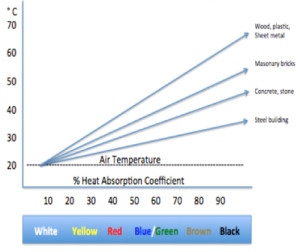Solar Reflective Coatings- a Deep Dive
According to EPA statistics, approximately $40 billion is spent annually in the U.S. to air-condition buildings. The incorporation of solar reflective pigments in paint can decrease the cost to air condition buildings in the U.S. by more than $8 billion.

When exposed to sunlight, it is commonly known that light colors, especially white, remain cooler than darker surfaces. Darker colors, especially black, absorb infrared light energy, resulting in warming of the substrate. The amount of light energy absorbed is dependent on color.
Other factors that determine an object’s temperature in an outside environment, in addition to it’s color and solar reflectivity, include it’s emissivity, convection and conduction. To illustrate further, Figure 1 indicates at an ambient air temperature of 20° C, a white object will remain at about 20°C, whereas a black object will be about 35° C for the coating surface of a steel building.
However this same black coating will have a surface temperature of about 65°C if the coated substrate is wood, plastic or isolated steel sheets. Key definitions follow:
Total Solar Reflectance – the amount of solar radiation that is reflected by a surface, measured as a percentage.
Thermal Emittance – the ability of a material to dissipate heat away from itself, or rather, to shed heat.
Convection – exchange of energy with air above the substrate.
Conduction – exchange of energy with the layer of the substrate directly below the surface.
To better understand the phenomena of why colors display different heating/cooling characteristics in sunlight, it is essential to examine the natural light spectrum. Solar radiation reaches the earth’s surface in three distinct wavelength packets. These packets of light include Ultra Violet light (UVA 280 – 315 nm, and UVB 315 – 400 nm), Visible light (400 nm – 700 nm) and Infrared light (near IR and far IR) between 700 and 2500 nm. The human eye sees light primarily in the visible portion of the light spectrum resulting in color. Some animal species, such as birds can see light in the UV portion of the spectrum.

Figure 2 illustrates the natural spectrum of solar radiation. 5% of the light energy is UV light, 46% is visible light, and the remaining 49% is infrared light energy. Pigments can absorb or reflect solar infrared energy resulting in 1) heat build-up of the coated substrate if the pigment absorbs IR energy (for example conventional darker pigments); or 2) little or no increase in temperature if the pigment reflects IR light (for example white and lighter colors).
Solar infrared energy (700 – 2,500 nm) is different than infrared energy emitted by hot objects in interior spaces, such as heaters. Infrared energy is found in the far infrared range beyond 1,200 nm.
To read the rest of the article, head on over to Prospector to check it out!

